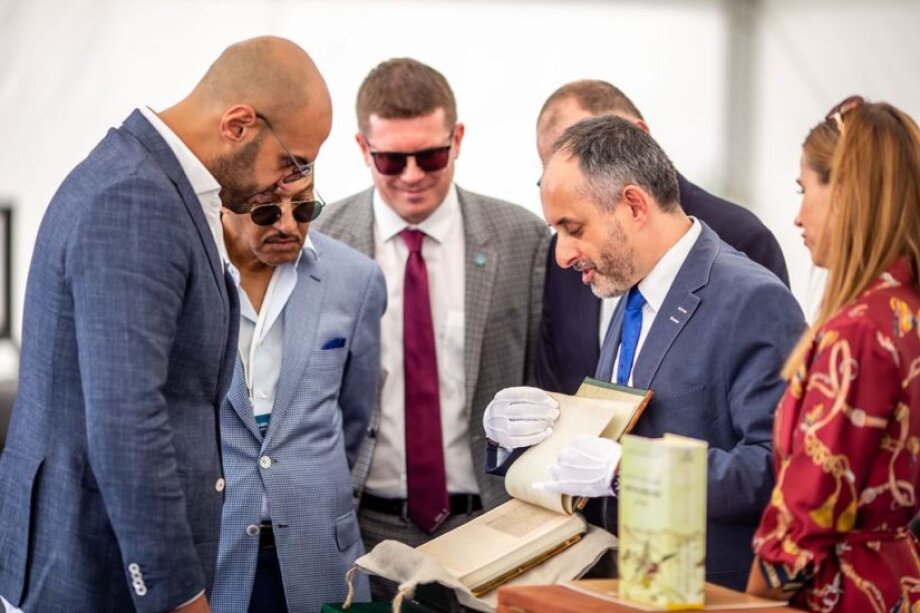Rzewuski's manuscript connecting Poland with the Arab World as a 'thank you'' for HRH Prince Khaled!


August the 16th in Nowe Wrońska during the 6th edition of the European Arabian Horse Festival - AKEAHF - where the European elite of warm-blooded "Arab’s breeders and enthusiasts" meet each year, His Royal Highness – festival founder and originator -
Prince Khaled Bin Abdul Aziz Al Saud received a facsimile (scientific copy) of
the Rzewuski Manuscript - a priceless encyclopedia of Arabian horse breeding,
tradition and culture of the Arabian Peninsula. The Manuscript, written by a
Polish count who 200 years ago set off with the mission of bringing this
beautiful horse breed to Poland and Europe, arouses admiration in Arab
countries and beyond. Manuscriptum Publishing House – the publisher of
facsimile and Al Khalediah Stud - the festival organizer gave the manuscript to
HRH on the hands of his son - Prince Fahad Bin Khaled al Saud, as a “thank you”
for choosing Poland for Al Khalediah
European Arabian Horse Festival where its headquarters continues here the
global breeding and promotion of Arabian horses, started by Emir Rzewuski in
the nineteenth.
It's been 200 years since the Polish magnate Wacław
Rzewuski set off on a journey to the Arabian Peninsula and began documenting
this fascinating history of Arabian horse’s breeding in his manuscript
"Sur les Chevaux Orientaux et Provenants des Races Orientales". Only
few people know that he arrived there 100 years before the famed Lawrence of
Arabia and became greatly recognized for his charismatic attitude and fight
with the Bedouins against the Turks. To celebrate this 200th anniversary, Manuscriptum Publishing House published a
facsimile of the most colorful of the three volumes of his manuscript, in the
form of the Jewelery Book, and will soon sets off with the Taj al Fahr 2020
project to proclaim the colorful history of the Polish Emir.
Rzewuski's Manuscript, whose facsimile was received by
HRH Prince Khaled is the only literary monument documenting the traditions,
customs and historical geographical data of that region. Al Khalediah Stud took
the patronage of the Taj al Fahr 2020 project, starting its promotion from the
6th edition of the AKEAHF Festival in 2019. The project will be continued
during cultural and horse events both in Poland and abroad. The mission of the
Taj al Fahr 2020 project - which is a cultural and economic bridge between
Poland and the Arab world - is to promote the Polish national heritage, which
the Rzewuski Manuscript is by it all means, dealing with the history of an Arab
horse written by a Polish protagonist, recognized by the Bedouin Emir.
This valuable facsimile of the Rzewuski Manuscript,
faithfully reproducing every element of its original: hand-pasted maps drawn by
Rzewuski, his numerous illustrations, old paper etc., was additionally dressed
in a gold and silver refined frame, emphasizing the value of the original.
"Polish diamond", as striped flint is called, adorns this setting by
emphasizing that the book is a bridge between Polish and Arabic culture.
There are some monuments of Polish literature which
make Poland known around the world. Copernicus, Chopin and Rzewuski left behind
a legacy valued on every continent, regardless of global trends. The latter is
known for describing Arab culture - never before or later - not described in
such detail in the context of the history of Arabian horses, made famous not
only the country of origin, but above all the world of the Arabian Peninsula.
In year 1817, this bold Polish magnate - from the most
prominent families -obsessed with hot-blooded Oriental horses, abandoned his
wife and wealthy estates and set for a fearless adventure in an area that was
unexplored and mysterious for most people at that time. His participation in
battles against the Turks, nis knowledge of horses and understanding of local
languages gave him recognition and friendship of 13 Bedouin tribes who give him
the dignity of an emir: official and military commander. Goldenbeard Emir - as
he was called - was the first European who crossed the vast, unexplored desert
of Najd in Saudi Arabia.
It was him who brought the first Arabian horses to
Europe and initiated the glorious tradition of breeding them in our region. He
bought stallions and mares for the Royal Wirtemberska Stud, Tsar Alexander I
from Russia, the French national stud in Pau and his own Sawran estate in
Ukraine. He lived a life full of romantic adventures. He quickly became famous
among the Arabs: stories were told about him and songs were sung, and Polish bards
like Mickiewicz and Słowacki did not omit his character in their work.
He left behind a beautiful legacy, his manuscript
"Sur les Chevaux Orientaux et Provenants des Races Orientales", which
until today is considered an priceless compendium of knowledge about Arab
culture and tradition and the art of breeding Arabian horses: their strains,
history, features and advantages.
This beautiful manuscript consisting of 352 pages and
218,000 words contains 65 charming sketches and over 100 other illustrations
and maps done by count himself. There are many portraits of Bedouin tribes in
Syria and Arabia, description of their history, customs, culture and unique
nomadic lifestyle. The manuscript is a total of over 400 colorful drawings,
which are a reach source of research on local culture and customs. There are
also notes that allow you to play Bedouin music from 200 years ago, as well as
a census of some tribes. All of that makes it a great value also for the
inhabitants of that region.